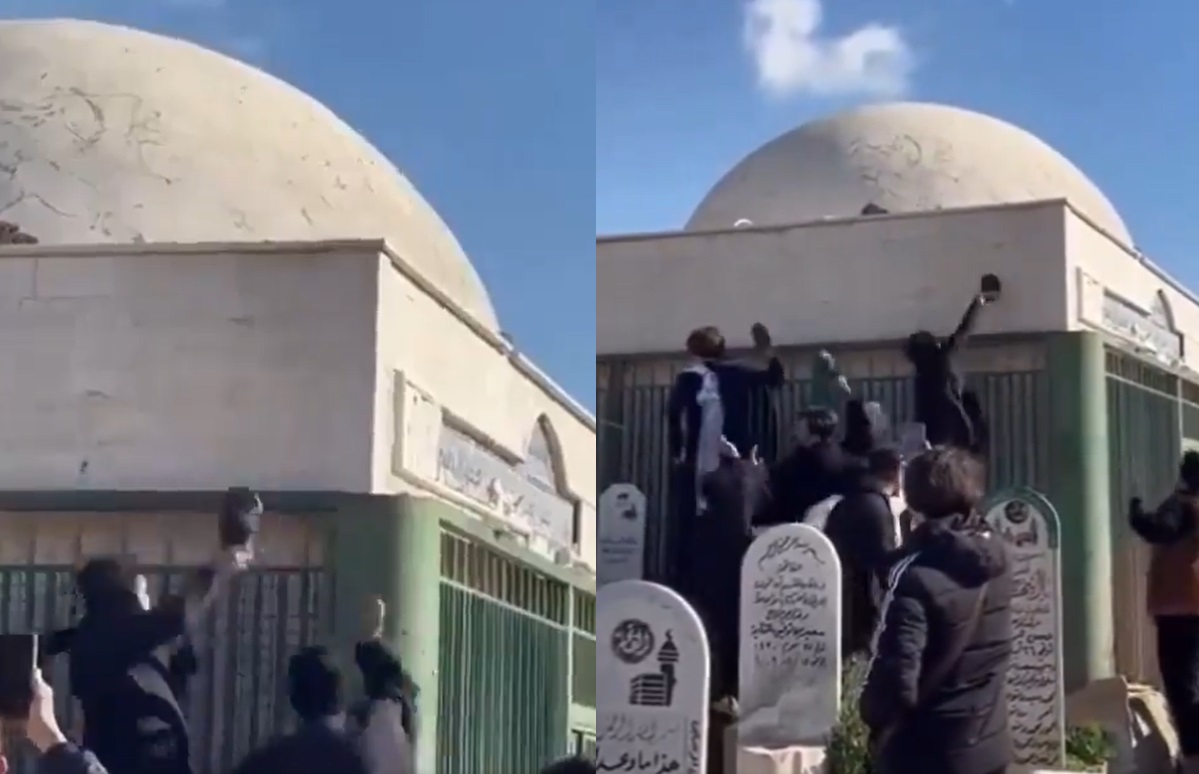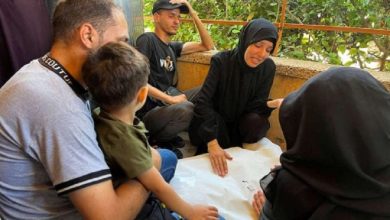Syrian Islamic Council Decries Sectarian Assaults: Attacks on Muslim Caliphs’ Tombs in Damascus Raise Alarms

Watan-“The Syrian Islamic Council” expressed its condemnation of the attacks by Iranian militias on the tombs of Muslim caliphs in Syria, especially in the city of Damascus, the capital of the Umayyad state.
Activists on social media shared videos showing Iranian militia groups attacking the tomb of the companion Muawiyah bin Abi Sufyan, striking it with shoes, while others chant the song “People should love you, O Ali.”
The Syrian Islamic Council, an opposition Syrian body, stated in a statement on its website that the attacks by Iran and its sectarian Shiite militias on Syrian cities, especially Damascus, the capital of the Umayyad state, have reached a dangerous level.
They have become a clear evil through the assaults on the Islamic history of Damascus and the humiliation of the tombs of Muslim caliphs, along with cursing their occupants.
The council, in its statement monitored by Watan, stated that this criminal aggression on Damascus and other Islamic world cities today will affect many Arab and Islamic cities if Arab and Islamic countries do not act to confront the expansionist Iranian threat.
هذا لو قبر علي ابن ابي طالب يضرب بالاحذيه
كان السنه المخانفه و السنه اتباع العلم الكهنوتي اشعلوا مواقع التواصل الاجتماعي
و كتبوا 👈قبر سيدنا الامام علي يضرب بالاحذيه الله اكبر ، عضو ب ال البيت يضرب شلت ايدكم
لكن مع معاويه يعمل روحه اهبل ما يشوف
pic.twitter.com/pF3xLA2J3E— Abo Sofyan (@abos0fyan) January 31, 2024
The statement emphasized that these sectarian practices take place in areas under the control of the ruling gang in Syria with its knowledge and complicity with the Wilayat al-Faqih system against Syria, its history, and its people. The council held this gang as an accomplice in the crimes that affect Syrians, Arabs, and Muslims as a whole.
The council called on the Arab and Islamic world to be more aware of the seriousness of the Iranian threat and to take action against it before it’s too late.
They prayed that Damascus and Syria would be cleansed from Iranian occupation and the gang colluding with it, and that Arab and Islamic countries would be protected from the evils of the Wilayat al-Faqih system and its militias.
This is not the first time that recorded videos of attacks on the mausoleum of Muawiyah bin Abi Sufyan in the Bab al-Saghir cemetery in Damascus have been circulated. Cameras have documented attempts to break the fence surrounding the shrine, throwing stones and shoes, and uttering offensive phrases in the area over the past years.
For unknown reasons, the mausoleum and the tomb of the companion, Caliph Muawiyah bin Abi Sufyan in Damascus, are shrouded in mystery and neglect.
لماذا يسمح نظام الأسد للزوار العراقيين بإهانة قبور الصحابة في دمشق وضربها بالأحذية التي تعبر عن قيمتهم وفهمهم وثقافتهم؟
هذا قبر معاوية بن أبي سفيان الشخصية التي أسست دولة حكمت المشرق والمغرب وتعتبر أكبر وأعظم دولة في التاريخ الإسلامي والعالمي
لو كان قبر مثل هذه الشخصية التاريخية… pic.twitter.com/rnCIxoubu5— قتيبة ياسين (@k7ybnd99) January 30, 2024
During the successive Ministries of Religious Affairs of the regime since 1970, this shrine has become a red line, preventing Syrians from visiting or approaching it. While Shiite visitors have been allowed to enter and desecrate it more than once, along with the surrounding graves of Muslims, which should also have their sanctity.
The mausoleum of the companion “Muawiyah bin Abi Sufian” is located in the Qaimariya neighborhood, behind the Umayyad Mosque, 50 meters after the Nofara Cafe. Through a narrow alley on the right, one can reach the real shrine. Muawiyah has several tombs in the Bab al-Saghir cemetery and the Amara neighborhood.
This shrine has been neglected for political and sectarian purposes, and strangely, no cleric or Minister of Religious Affairs has dared to speak about the shrine. It is not the Ministry of Religious Affairs that grants permission; it communicates with the intelligence administration for that purpose.
هذا المشهد في دمشق لمجموعة من اتباع إيران بتدنيس قبر معاوية. المشكلة هنا تتعدى الإشكالية الطائفية التي لم تعهدها الشام من قبل، إلى إشكالية الهوية الثقافية التي ضاعت أو تكاد بعدما جرى التنكيل بالمجتمع السوري، وتدمير أسسه الحضارية لا سيما بتهجير نحو نصف سكانه وتدمير حواضره الكبرى… pic.twitter.com/MjSv3ExTr0
— Siba Madwar صِبا مدور (@madwar_siba) January 31, 2024
The shrine appears to be a security zone that no one dares to approach, even tourists. Despite Hafez al-Assad, according to regime propaganda, considering the life of Muawiyah as an exemplary model for political rule.
Shiites accuse the revered companion Muawiyah bin Abi Sufyan of desecrating the graves of the Prophet’s family and ordering the Imam to be insulted from the pulpits, a false accusation that led the Syrian regime to neglect the tomb to this extent.
According to activists, there have been several attempts by extremist Shiites to reach the shrine for nefarious purposes. Fortunately, the shrine is protected by a group of houses; otherwise, it would have been dug up and demolished. Being in a crowded and inhabited area has made it difficult to reach, as it needs restoration and cleaning from the inside, but it has never been violated.
Social media users had diverse reactions to the attack on the tomb of Caliph Muawiyah. They considered it an expression of historical sectarian hatred against Sunni Muslims wherever they are.
Syrian journalist Qutaiba Yassin questioned why the Assad regime allows Iraqi Shiite visitors to insult the tombs of companions in Damascus and strike them with shoes, which reflect their values, understanding, and culture.
He added that Muawiyah bin Abi Sufian, the founder of the Umayyad state, is a person whose life and legacy are admired, being the ruler of the East and the West and considered the greatest Islamic state in history.
Regarding the identity and culture issue, journalist Saba Mador stated that the problem goes beyond sectarian issues unprecedented in the Levant, reaching the problem of cultural identity that has been lost or almost lost after the Syrian society was tortured and its civilized foundations destroyed, especially with the displacement of nearly half of its population and the destruction of its major cities.
نظام الأسد يسمح للزوار العراقيين الشيعة بضرب وإهانة قبر معاوية بن أبي سفيان رضي الله عنه في دمشق..
ثم يتهمونا بأننا طائفيين!! pic.twitter.com/dizFPk1Hrj
— مُضَر | Modar (@ivarmm) January 30, 2024
Social media users expressed their frustration and disbelief at the actions of those attacking the shrine, highlighting the negative impact of ignorance on societies. They emphasized the importance of progress and prosperity, stating that any society hindered by delusions is a failed society and belongs to the lower ranks of nations.
The incident prompted criticism of the Assad regime, with comments indicating that it allows Shiite visitors from Iraq to insult and desecrate the tomb of Muawiyah bin Abi Sufian in Damascus and then accuses others of being sectarian.
Users emphasized the need for rationality and common sense, questioning how a person with a sound mind would resort to such actions. They concluded that Muawiyah bin Abi Sufian is not harmed by their ignorance, as his fate lies with his Creator in the highest levels of bliss.





